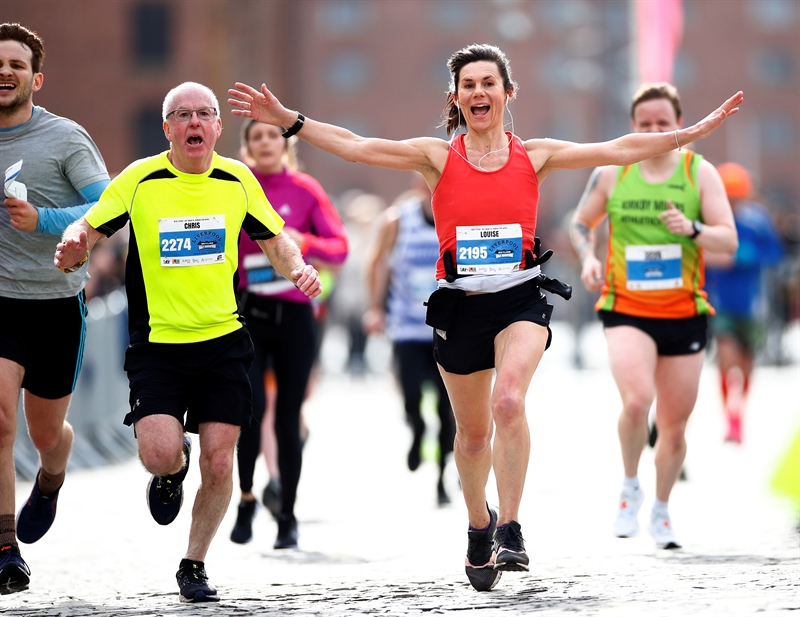Strength training for runners: what’s the ideal recipe?

Now that concerns over the spread of the coronavirus have halted nearly all organized team sports, more athletes will be running to stay fit. However, running is associated with some of the highest injury rates within sport, causing around 30-50% of all injuries(1). Between 70% and 80% of all runners will report an injury each year(2). This high rate of injury may be due to the constant, repetitive nature of the running action, resulting in an accumulation of impact stresses.
Strength training helps prevent these running-related injuries. However, middle to long-distance runners struggle to add workouts to their extensive and time-consuming training plans. The physiological, biomechanical, and psychological demands of their events require frequent running sessions, which leave little room for additional training elements(3).
Strength-training also improves running performance by helping athletes run more efficiently. One metric of this efficiency is a measurement of the amount of energy it takes to cover a certain distance at a particular pace, known as running economy (RE). Runners who include resistance training in their program show a two to eight percent enhancement in running economy (RE)(4). Improvements in RE allow a runner to run faster over a given distance, or run longer at a constant speed with less oxygen and energy expenditure(3,5).
Running economy is a key performance indicator for distance runners(6). Improvements in RE require the generation of rapid force during ground contact to enhance the strength and speed of the run(7). Strength training elicits adaptations in the muscles that facilitate the absorption of ground reaction forces and enhance the magnitude and rate of forces produced by the legs(8). These adaptations are associated with improved RE, faster time-trial performance, and faster maximal sprint speed(9). When runners stop strength training, they notice performance losses within six weeks(10).
How strength training improves running economy
Strength training using an external load causes overload to the neuromuscular system. This demand on the neuromuscular system promotes motor unit recruitment, firing frequency, and intramuscular coordination(3). With resistance training, more muscle fibers are activated earlier, in greater number, and more efficiently.Improved coordination between muscle units produces a faster rate and capacity for force development. This higher force-generating capacity spares energy (for any given pace) by building speed, power, and strength reserves. A stronger runner, therefore, requires a lower percentage of maximal strength to execute the running action, thus reducing the need for anaerobic energy (11). Less energy expenditure also contributes to fatigue management and reduces the risk of injury.
Mechanical overload also causes tendon adaptations. In particular, calf muscle strengthening increases Achilles tendon stiffness. Stiffer tendons reduce the magnitude and velocity of the muscle shortening length, thus lowering energy expenditure (as there is less muscle activation required)(3,8).
Sports-specific strength training exercises develop muscle fibers in the range of movement essential to that sport. For an effective running weight training program, build strength in the primary muscles and within the joint ranges that mimic running. These types of exercises also lay the foundation for progressing to power development using plyometrics activities.
Types of strength exercises
Running is a dynamic, multi-joint movement, so use multi-joint strength exercises to induce greater training transfer. Free-weight exercises provide greater neuromuscular stimulus than machines. They demand increased coordination, multi-directional control, and activation of multiple muscle groups. Olympic lifts generate whole-body strength and power, and require force generation from closed-chain positions. These exercises bears a biomechanical similarity to the action of running and challenges trunk and upper limb control and coordination. Therefore, for maximum impact, master lifts such as the power clean or the clean and jerk early on.Running-specific strengthening programs often target the hip muscles, which are integral to running biomechanics as they link the trunk to the lower limb. Hip extension is regarded as the most fundamental movement as it generates the force that propels the runner forward(12). Hip extension exercises include squats, lunges, glute bridges, and deadlifts (see program 1)(6,12).
Program 1: Hip extension exercises




Exercises to strengthen hip extension include (clockwise from top left) the banded squat, step-back lunge with bicep curl, bridge with ball, and unilateral bridge with ball.
Over-focusing on sagittal plane movements may be detrimental to the frontal plane gluteal muscles - gluteus medius and gluteus minimus. These lateral muscles stabilize the hip joint throughout each phase of the running cycle. A weakness here contributes to increased hip and knee adduction and a frontal plane pelvic drop, both of which can lead to altered biomechanics and injury. Therefore, include hip abduction strengthening in the routine as well (see program 2)(12).
Program 2: Strengthening exercises for hip abductor muscles



Hip abductor muscle strengthening exercises include (clockwise from top left) the clamshell, side plank, and side lying abduction.
Following sagittal and frontal plane exercises, progress to unilateral, closed-chain exercises to stabilize the hips during the single-leg stance phase of running(12). Finally, add plyometrics strength exercises to generate power with speed. Examples include squat jumps, box jumps, drop jumps, bounds, hurdle hops(6).
Exercise prescription
Insufficient overload when seeking training adaptations is counterproductive; the extra training tires the runner but doesn’t produce strength gains. Therefore, training programs must provide adequate strain on the muscles. This level of resistance training is generally associated with hypertrophic changes ie increases in muscle mass. Runners may hesitate to increase mass as they believe the fallacy that one must be ‘thin to win.’ Exactly the opposite is true. Runners need adequate muscle mass to generate power and speed. This goal was previously associated with high-repetition, low-load training to reflect the endurance element of running. However, research suggests runners should gain endurance from running rather than weight training. Strength training should focus on just that - developing mechanical and structural strength(9). Careful exercise prescription is essential to produce this formula.| Type of training | Definition | Prescription |
|---|---|---|
| Light strength | 40-60% 1RM | 3-5 sets of 20-30 repetitions |
| Heavy strength | Greater than or equal to 70% 1RM | 3-6 sets of 6-10 repetitions with 2-minute rest intervals |
| Explosive strength | Medium to high load (75-90% 1RM) | 1-4 sets of 3-5 repetitions |
| Plyometrics | Low load, high-velocity | 1-6 sets of 4-10 repetitions. 110-228 foot contacts per session |
NB: 1RM= the maximum an athlete can move in one repetition.
Runners should perform heavy strength training with the formulas described in table 1. However, novices may commence at the lower end of sets and reps and gradually work up to the higher ranges. Distance runners should combine strength and plyometric based exercises at a moderate intensity to develop power throughout their race duration. Short distance runners (eg 5km) should focus more on explosive strength and plyometric based exercises. This generates more power with each stride while using the same amount of effort. A strength-training schedule should target an athlete’s weaknesses or areas susceptible to injury, as well as race-specific training (see table 2).
| Day | Focus | Exercises |
|---|---|---|
| Day 1 | Push | Squats, lunges, jump squats |
| Day 2 | Pull | Deadlift, good mornings, hamstring curls |
| Day 3 | Light combination | A mixture of day 1 & 2 exercises but with less load and intensity. |
Training scheduling
A concurrent training approach schedules resistance training sessions alongside running training(6). This strategic planning allows maximal benefits and lengthier rest periods for the runner. Perform strength training about three times per week during the training season, and reduce to 1-2 times per week during the four weeks before a competition(3). Schedule strength training on the same day as running training so that when the athlete has a rest day, it is a full day of rest. This method provides a longer period for muscle recovery and, therefore, maximizes performance during training sessions.The prime goal of training for runners is to improve running performance. Therefore, the running session should occur first to allow maximum effort. Resistance training before running impairs muscle contraction and negatively impacts running performance(6). Strength sessions are best completed approximately four to six hours following running; this helps eliminate the residual fatigue effects from running(13).
Since a 12-week strength plan is necessary to exhibit change to RE and time trials, plan strength-training programs well ahead of competition dates(14). However, concurrent training that includes heavy strength work may produce changes in RE within four weeks(15). To further enhance running performance, employ complex resistance training. This method involves supersets of two different exercise modes, such as heavy resistance and plyometric training. The combination provides the best outcomes for strength, power output, and RE(16).
In summary
- Running-specific resistance-training programs should strengthen hip extension and abduction, and include unilateral closed-chain exercises and plyometrics.
- Distance runners should perform three to six sets of six to 10 repetitions using 70% of 1RM weight (rather than light weight/high volumes).
- Concurrent training that employs a mixture of heavy resistance training and plyometrics alongside running produces the best outcomes.
- Heavy resistance training is best scheduled on the same day as harder runs to allow better recovery on rest days.
- Part II of this series will explore how strength training contributes to injury prevention.
References
- Sports Med. 2012; 42(10):891-905.
- Med Sci Sports Exerc. 2004; 36(5):845-849.
- Sports Med. 2018; 48:1117-1149.
- Br J Sports Med. 2018;52:1557–1563.
- Sports Med. 2003; 33:539-552.
- J Strength Cond. 2020; 42(1): 97-106.
- Sports Med. 2014; 44(6): 845-865.
- Br J Sports Med. 2019. 10.1136/bjsports-2019-100840.
- Br J Sports Med.2019. 10.1136/bjsports-2019-10116
- Int J Sports Physiol Perform. 2016; 11:80-85.
- Front Physiol. 2017;8:433. doi.org/10.3389/fphys.2017.00433.
- J Strength Cond. 2020; 42(1): 60-66.
- Appl Physiol Nutr Metab. 2013; 38:651-656.
- J Strength Cond Res. 2013; 27:2433-2443.
- Int J Sports Med. 2009; 30:27-32.
- PeerJ 7:2019. e6787.
You need to be logged in to continue reading.
Please register for limited access or take a 30-day risk-free trial of Sports Injury Bulletin to experience the full benefits of a subscription. TAKE A RISK-FREE TRIAL
TAKE A RISK-FREE TRIAL
Newsletter Sign Up
Subscriber Testimonials
Dr. Alexandra Fandetti-Robin, Back & Body Chiropractic
Elspeth Cowell MSCh DpodM SRCh HCPC reg
William Hunter, Nuffield Health
Newsletter Sign Up
Coaches Testimonials
Dr. Alexandra Fandetti-Robin, Back & Body Chiropractic
Elspeth Cowell MSCh DpodM SRCh HCPC reg
William Hunter, Nuffield Health
Be at the leading edge of sports injury management
Our international team of qualified experts (see above) spend hours poring over scores of technical journals and medical papers that even the most interested professionals don't have time to read.
For 17 years, we've helped hard-working physiotherapists and sports professionals like you, overwhelmed by the vast amount of new research, bring science to their treatment. Sports Injury Bulletin is the ideal resource for practitioners too busy to cull through all the monthly journals to find meaningful and applicable studies.
*includes 3 coaching manuals
Get Inspired
All the latest techniques and approaches
Sports Injury Bulletin brings together a worldwide panel of experts – including physiotherapists, doctors, researchers and sports scientists. Together we deliver everything you need to help your clients avoid – or recover as quickly as possible from – injuries.
We strip away the scientific jargon and deliver you easy-to-follow training exercises, nutrition tips, psychological strategies and recovery programmes and exercises in plain English.










